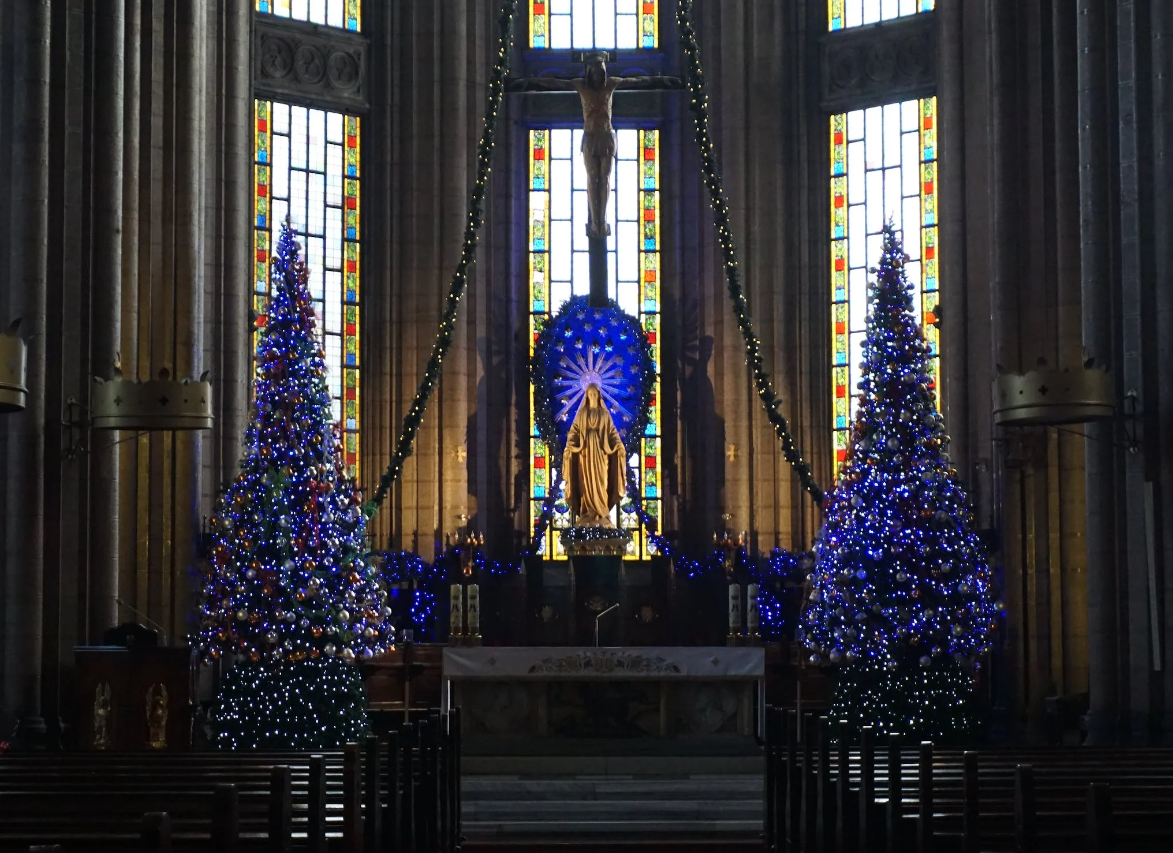What Religious Freedom Requires
Religious Literacy & the Flying Spaghetti Monster
by David Callaway and Hannah Santos
Photo: Ed Uthman, C.c. 2.0, BY-SA
Long-time advocates of religious freedom paused when Eddie Castillo successfully used the First Amendment to wear a pasta strainer on his head for his drivers license photo. Castillo, a Pastafarian, argued the colander qualified as religious dress because it symbolizes the spaghetti-shaped deity central to his tradition. While fellow Pastafarians applauded the decision, others were left bewildered. Pastafarianism, also known as the Church of the Flying Spaghetti Monster, is often brushed off as “satire religion” for its seemingly absurd beliefs and practices. However, the tradition contains clearly written moral commandments, mythology, and sacred texts. So, does it count as a “real” religion? Is it protected by the First Amendment? What limitations do our seemingly static definitions of religion create when trying to answer these questions?
The Quest for Religious Freedom
Religious freedom is a continually fluctuating concept. As religious studies scholars and constitutional lawyers continuously repeat, there is no single comprehensive definition of religion. Our courts have tried and failed to standardize what “counts” as religion, attempting to balance the inherent exclusion required to define a word and the potential consequences of too broad a definition. But how can the law regulate that which it cannot define? How can we pursue religious freedom if we cannot agree as to what it means and to whom it applies? These questions plague First Amendment experts, and while this essay contains no concrete answers, we offer a powerful entry point into the discussion — religious literacy.
Religious literacy is a critical competency for citizens in a religiously pluralistic democratic society and a requirement for generative religious freedom discourse. Respect and cooperation depend upon the ability to understand diverse perspectives with nuance and empathy and to maintain that understanding even in complex decision-making, when strong feelings can emerge. In moments when productive compromise is most critical, a superficial understanding is rarely enough to sustain meaningful long-term cooperation. Instead, American citizens must internalize a substantive and respectful grasp of the values and concerns that motivate their neighbors.
The tools necessary to have honest, productive, critical conversations about religious freedom are rooted in religious literacy. Without a shared language and the ability to properly “see” religion in the room, religious-freedom work will fall short. Below is an outline of the essential knowledge, skills, and dispositions needed to meaningfully engage with religious literacy and religious freedom.
Developing a Shared Language
Religious literacy education builds the critical knowledge base upon which generative religious freedom conversations are held. Citizens require a shared language assembled from a credible foundation of academic knowledge about the beliefs and practices that inform daily life for others. We cannot have a conversation about religious freedom without basic knowledge of the religious traditions in our country. We cannot defend the religious freedom of our neighbor without knowing who our neighbor even is.
Photo: Pxhere
Basic knowledge about religious traditions – central theological tenants, major holidays, important rituals, etcetera – may seem rudimentary, but are a crucial first step in the discussion. This factual foundation must involve both a long-term historical perspective honoring the evolving context that shapes all religious traditions, as well as an accurate picture of the reality of daily practices of believers and non-believers in the contemporary world. Religions exist in continuous evolution, and while having baseline knowledge of a tradition is important, religious literacy demands we acknowledge and leave room for the infinite exceptions to the baseline.
The shared language of religious literacy fosters the ability to recognize internal diversity within religious faiths and to anticipate the often idiosyncratic vantages of individual believers. It encourages respect and appreciation for the ways religions have shaped and are shaped by our global, national, and local communities. It supports effective interpretation of religious symbols, statements, and practices based on their own intention rather than through the lens of narrow or misleading outsider assumptions.
Photo: Pexels
It is worth acknowledging the notion of internal diversity can complicate and, at times, disrupt the paradigms with which lawyers and judges approach the boundaries of religious freedom. It is reasonable and necessary to expect legal professionals to respect the inherent internal diversity of all religious communities, but does that mean all claims made by religious communities should be considered equally protected under the law?
Any individual may claim a unique belief or practice – however seemingly irrelevant – is commanded by their religious tradition. If taken to its most extreme, internal diversity demands we take this seriously. This religious literacy framework calls for intellectual humility in the face of unfamiliar or unusual religious claims. However, does that mean every belief claiming to be sincerely religious should be considered equally valid in the eyes of the law? Practically speaking, this would create a throng of problems for lawyers and judges. The methods legal professionals use to assess the religious validity of sincerely held beliefs is a complicated topic beyond the scope of this essay. We insist greater attention to internal diversity is beneficial for religious freedom overall, while also acknowledging that it disrupts the categories of religion currently required for legal decisions.
The internal diversity of our pluralistic nation demands that our education demonstrate serious concern for a range of minority faiths in addition to major traditions. We must hold respectful curiosity and sincere engagement with the goal of developing an informed understanding of core values. Without the shared language of religious literacy, dialogue about the landscape of religious freedom is inherently restricted.
Finding Religion in the Room
Along with shared language, religious literacy demands the ability to recognize and analyze religion in the public sphere where it often goes unnoticed. Religious literacy education develops a lens focused on the embedded nature of religion in seemingly “secular” spheres – the sites most commonly featured in controversial religious freedom cases.
The mutual influence of religion and political, economic, and social change is rendered invisible by inaccurate but commonly held narratives about religion as an inherently private phenomenon. Far too often people assume religion – and by extension, religious freedom issues – begins and ends within places of worship. In reality, many of the most pressing religious freedom cases concern the public sphere. It is often in spaces where religion is assumed not to be, that these questions become critical. Battles for religious freedom do not often happen in churches themselves. They happen in the workplace, parks, and in public schools.
Within the US American context, Christianity – particularly Protestantism – remains the most common religious tradition. When operating in spaces seen as “secular,” individuals incorporate and embody Protestant values and practices, often unconsciously.
Photo: Pexels
One common example of this phenomenon is corporate offices that take time off for Christmas, but not for other religious holidays. It is common to expect businesses to be closed on Christmas in the US, even if the business has no formal religious affiliation. More often than not, closing businesses on Christmas is seen as a standard and neutral decision. Of course, this is not the case. While workers who observe non-Christian holidays are forced to request time off – potentially unpaid time – workers who observe Christian holidays are not met with the same burden.
Religious literacy provides us with the tools to ask and answer the question: where is religion in the room? How might your workplace meeting schedules disrupt prayer schedules? How might the dress code in the military implicitly discriminate against students of a religious minority? How might the cafeteria options in your location public school make it difficult for children who eat kosher or halal? Without the ability to recognize and analyze the presence of religion, the experiences of religious minorities in the public square often go unaddressed.
Putting Religions Literacy to Work
Religious identity travels with us into the public sphere creating a diverse, democratic society within which we must find a way to live together despite deep differences. Diversity of thought, experience, and belief is not only a right but also an advantage to the shared goal of a harmonious society enriched by vast internal complexity. While the letter of the First Amendment guarantees religious freedom by mandating government neutrality and by protecting the right of every individual to follow the dictates of conscience, these guarantees still require a critical mass of citizens to uphold the spirit of the First Amendment to counter the increasingly incendiary rhetoric and personal attacks that have become commonplace in our culture.
In this capacity, the religious freedom clauses of the First Amendment can act as articles of peace, creating a civic structure for navigating the diversity that is a fact of American life. When we all acknowledge the fundamental human rights and dignity of each other, respect across difference can be built.
Therefore, robust religious literacy education is a tool for peace, justice, and progress. Religiously literate Americans are able to dispel stereotypes and lift up respect for individual practice and diversity of belief. By countering generalizations with accurate and specific knowledge, religiously literate citizens dispel fear and ground productive conversations in an accurate view of the starting vantage of all parties.
The American experiment in pluralistic democracy is neither destined to succeed nor intrinsically doomed. How we have conversations and build community across our deeply held differences depends both on the constitutional guarantee of religious liberty and a commitment to understand our differences. The intersection of religious freedom and religious literacy is an opportunity to exercise the American values of equal protection under the law paired with an equal ability to live according to one’s deepest beliefs.
Header Photo: Daniel Arrhakis, C.c. 2.0, BY-NC








